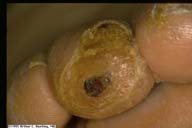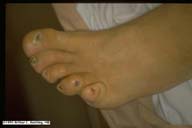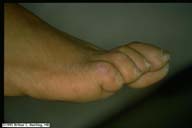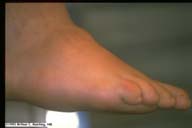Photoessay: The Skin and Diabetes Mellitus
by A Huntley
Dermatology Online Journal, December 1995
Volume 1, Number 2
Diabetic Neuropathy of the Foot
sensory neuropathy
motor neuropathy
Charcot foot
additional images of neuropathy
sensory neuropathy
Another major complication of diabetes mellitus is development of neuropathy. Relative to the skin, the most common manifestations
involve legs and feet. Sensory neuropathy allows trauma to occur to the feet from ill-fitting shoes which may then result
in ulceration.


Figs 31,32. Two illustrations of diabetic sensory neuropathy of the foot. The affected foot on the left has callus and ulcer
on the distal aspect of the right second toe. The patient was unaware of the ulcer. The foot of the diabetic patient shown
on the right has multiple erosions on the dorsal aspect of the toes. The patient was unable to feel the trauma which initiated
these wounds.
motor neuropathy
Motor neuropathy results in weakened intrinsic foot muscles. The toes dorsiflex and the foot splays (becomes wider) on weight
-bearing. This new shape may no longer fit the previous shoes and, along with sensory neuropathy, may potentiate trauma and
ulceration.

Fig 33. Foot of diabetic patient with motor neuropathy. Note that the toes are being drawn upward.
Charcot foot
With loss of sensation and weak intrinsic muscles, the foot may fracture when stressed. Multiple fractures allowed to heal
without realignment result in the distortion of shape.

Fig 34. Foot of a diabetic patient who has sensory and motor neuropathy. She started to run bare foot and heard the snapping
sound in her feet . The foot was allowed to heal without medical intervention.
additional images of foot neuropathy
All contents copyright (C), 1995.
Dermatology Online Journal
University of California Davis

